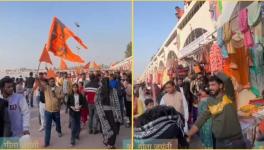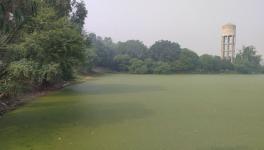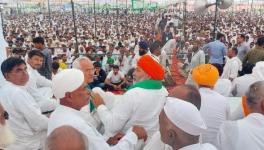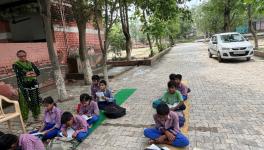In Dera Sacha Sauda, the Burden of History

image Courtesy: The Indian Express
As the worthy citizenry of an enormous democracy, the largest in the democratic world, politics has not been very kind to us. Such is the unkindness of politics that a concatenation of progressive judgements, as has been the character of this month, evokes portentous surprise. This is what makes the reiteration of fundamental rights a significant act of faith in a faithless country. On 25 August, 2017, a special judicial court of the Central Bureau of Investigation (CBI) convicted Gurmeet Ram Rahim Singh, chief preceptor of the Dera Sacha Sauda (DSS), in a rape case that the Punjab and the Haryana High Court had directed the CBI to pursue, taking suo moto cognisance of anonymous letters written to (then) Prime Minister Atal Bihari Vajpayee. On 28 August, 2017, it sentenced him to twenty years of imprisonment. Buried in the anonymity of the letters were the experiences of two sadhvis of the dera, unfurling a dark, inescapable world of quotidian harassment and sexual violence, or what Singh, their baba, would call maafi, forgiveness for their intrinsic impurity.
But the universe of dera followers is textured beyond the spontaneity of their violence, even as it is performed spontaneously. The fulcrum of the dera is a history of social and political exclusion in Haryana and Punjab. History, once invoked, asks that we unravel the comfort of narrative. The judgement may be historic, but it is also historical.
Much before the verdict of conviction was pronounced, followers of the dera had begun to assemble en masse in Sirsa, Haryana, furious at the audacity of justice. One impassioned devotee, asked to reflect on the possible conviction of her pita-ji, remarked that if something were to happen to him, they (presumably, one hopes, the gathering of devotees) would not take a minute to obliterate India from the map of the world. This sense of murderous rage was to manifest, thereafter, as the news of Singh’s conviction was rendered public. Hundreds, if not thousands, of dera devotees initiated wanton rampage – torching buses, trains, property, killing thirty and injuring about three hundred in the scuffle with army and police personnel. Despite the rhetoric of preparedness, the police and the army witnessed the spectacle with peculiar impotence, letting hundreds of devotees gather and the gathering become a homicidal mob. The aftermath of the sentencing was relatively sombre, as anticipated by a fretful and copiously armed police force. It is not to implore similar conduct to remember what public agitation does to Kashmir. Unlike in the proverbial mainland, life demands the miracle of rationale. Death is business as usual.
But the universe of dera followers is textured beyond the spontaneity of their violence, even as it is performed spontaneously. The fulcrum of the dera is a history of social and political exclusion in Haryana and Punjab. History, once invoked, asks that we unravel the comfort of narrative. The judgement may be historic, but it is also historical.
The fable is as early as the national agrarian distress in the 1950-60s and its revolutionary remedy developed in Haryana and Punjab, referred to as the Green Revolution. At the edges of a famine that threatened the economic and political basis of postcolonial India, dismal agricultural productivity led pioneers as geneticist M.S. Swaminathan and others to the desperation of a "package" that could rapidly overhaul productivity and eventually, execute a restructuring of Indian agriculture – that the latter ambition remains distant accrues as much to the revolution as to "liberal" economic reforms, re-initiating the Indian agrarian milieu into deflationary economic policy, pliable agriculture, and forces of neo-imperialist dependency. The Green Revolution envisioned a radical reform in agro-economic technology through fecund land reform, rural infrastructure, irrigation and the synthetic application of fertiliser and pesticides, and more critically, the high-yielding seed variety. It was seen as the doyen of self-sufficiency, as even in the 1960s, India was dependent on the United States for food aid, mandated by the Public Law 480 program of the American government – a program deployed strategically in the political skirmishes of the Cold War with the Soviet Union.
Disease is only one of the maladies of a region that has seen considerable militancy, sustained crop failures, the devastation of its agrarian economy, and the eventual turn to opium cultivation. Little remains to be written of Punjab’s opium predicament. About 45-50% of drug seizures in India (testified by a Narcotics Control Bureau report) and cases lodged under the Narcotic Drugs and Psychotropic Substances Act (NDPS) come from Punjab.
The fundamental problem with the Green Revolution was not that it was unsuccessful, but successful beyond imaginable measure. India, with a sense of an ancient civilisation arising from the profound slumber of colonialism, achieved self-sufficiency in food for the first time in its history. From an overall foodgrain production of 82 million tonnes in 1960-61, the productive output increased to 108 million tonnes in 1970-71, to 130 million tonnes in 1980-81, and further, to 175 million tonnes in 1990-91. (K.S. Gill, 1993) The magnitude and rapidity of its success quelled the agrarian crises but prefigured others. An illustration of these is the “Cancer Train” of Punjab and Haryana, regularly carrying patients ruined by decades of fertiliser percolation. A survey conducted by Greenpeace India in 2009 evidenced alarming levels of nitrate pollution in drinking water extracted from wells, as many as one in every five, in rural Punjab, attributing it to the intensive farming practices and an excessive use of nitrate fertilisers. “We did not realise the water had become poisonous,” narrates a farmer taking his wife to Bikaner for oncological treatment in a testimony. Disease is only one of the maladies of a region that has seen considerable militancy, sustained crop failures, the devastation of its agrarian economy, and the eventual turn to opium cultivation. Little remains to be written of Punjab’s opium predicament. About 45-50% of drug seizures in India (testified by a Narcotics Control Bureau report) and cases lodged under the Narcotic Drugs and Psychotropic Substances Act (NDPS) come from Punjab. In many ways, opium is the legacy of the revolution. Like all legacies, it is difficult inheritance.
About 20-25% of the population in Punjab, the Jat Sikhs possess over 90% of the agricultural landholding, as do the Jats in Haryana where they are only little over 25% of the population. The “dalit” castes in Punjab and Haryana, such as the Mazhabi Sikhs, shamars, balmikis, and the bazigars constitute a sizeable demographic share in the region, the highest in Punjab, but find themselves in an extricable historical marginalisation.
The terrain of a rapidly devastating agrarian economy in the region is a fractured historical sociality. Despite assiduous attempts to present it as an ancient afterthought, caste remains a significant cleavage. In Punjab and Haryana, it has perpetuated the economic ascendancy of a demographically minuscule elite in landholding and commerce. About 20-25% of the population in Punjab, the Jat Sikhs possess over 90% of the agricultural landholding, as do the Jats in Haryana where they are only little over 25% of the population. The “dalit” castes in Punjab and Haryana, such as the Mazhabi Sikhs, shamars, balmikis, and the bazigars constitute a sizeable demographic share in the region, the highest in Punjab, but find themselves in an extricable historical marginalisation. Economic ascendancy is also an ascendancy of faith as even lower-caste converts from the oppressive “Hindu” caste order to Sikhism are systematically excluded from the Shiromani Gurdwara Parbandhak Committee (SGPC) at whose commanding heights are the dominant castes, particularly with the proliferation of caste-gurdwaras. Sikhism, although theologically egalitarian unlike what is now known as Hinduism, has a chequered contemporary history of caste discrimination and subordination. Harjot Oberoi, in his magisterial scholarship on religious boundaries, has argued that while Sikh affiliation has historically coexisted with other identifications, it is only with the rise of the Sikh Sabha at the turn of the nineteenth century that an attempt to recast Sikh identity was made, at the centre of which was an old elite with ethnocentric notions of newness and cultural innovation.
To a people denied materiality and faith by the dominant, the dera is even salvation. Yet, the dera is as emancipatory as caste, invaginated in the same circuits of exploitation and political intimidation. From relatively humble beginnings, Gurmeet Ram Rahim Singh amassed a veritable empire, vacillating from the Indian National Congress (INC) to the Bharatiya Janata Party (BJP) to enhance his political position whilst furnishing for the political parties a seasoned votebank to appropriate.
The dera, or the dera culture, is this promise, a para-theological avenue of social emancipation for the marginalised. The Dera Sacha Sauda is one of many such traditions, transcending the differentiation that creates temples and caste-gurdwaras. It is not surprising that its followers come, by and large, from the most marginalised castes; in fact, it is only programmatic. The suffix to all names for adherents is insaan, human, to emphasise the intrinsic humanity unfettered by caste. For the starving, something as essential as food can mean the world – and indeed, in Haryana, it does. Subsidised ration for the poor, an unfulfilled prerogative of the government, is the triumph of the dera. In disease-ridden districts of Punjab like Faridkot and Ferozepur, the DSS commands vast influence for the medical facilities it provides without charge. Its rehabilitative programmes for opium, alcohol, and other addictions have cohered considerable support. In engaging with the legacies of the Green Revolution, the dera, too, has become one. To a people denied materiality and faith by the dominant, the dera is even salvation. Yet, the dera is as emancipatory as caste, invaginated in the same circuits of exploitation and political intimidation. From relatively humble beginnings, Gurmeet Ram Rahim Singh amassed a veritable empire, vacillating from the Indian National Congress (INC) to the Bharatiya Janata Party (BJP) to enhance his political position whilst furnishing for the political parties a seasoned votebank to appropriate. From prescribed vegetarianism to naked extortion, caste is the political template of the dera, even as it claims to transcend it. Sexual violence is an organism of the culture of preying on the vulnerable that the dera has perfected through its tumultuous years. The maafi, as one of the letters described, would begin with being summoned to the guru’s gufa where he would be found watching pornography, a revolver by his side. There is no doubt, he would say, that he was God. Just as Sri Krishna enacted the prem-lila with his gopis, so could he. Resistance to his advances would be quietened by a fear of the revolver and the threat of an unintelligible death that devoted family members will never oppose. Such is the quietude of its author that little remains to be said but anonymity.
Gender, like history, once invoked, demands that we unravel the comfort of narrative. It is our ignominy as an enormous democracy, the largest in the democratic world, that the anxiety to militate against the prosecution of a rapist finds prevalent empathy.
Gurmeet Singh is no icon of the marginalised, even if he has held a certain iconography to the marginalised. His rioting devotees may be subaltern, but their assertion is in defence of a man who raped and against a familiar world where the dera proffered a semblance of acceptance. Of the violence, there is no defence; indeed, to trivialise it because its perpetrators are marginalised would be to deny them the complexity of a gendered life. Gender, like history, once invoked, demands that we unravel the comfort of narrative. It is our ignominy as an enormous democracy, the largest in the democratic world, that the anxiety to militate against the prosecution of a rapist finds prevalent empathy. As the discourse on the conviction takes the face of Gurmeet Ram Rahim Singh and those rioting in his name, it is to the courage of the two sadhvis who wrote to the Prime Minister, the patience of their despair that I turn.
Disclaimer: The views expressed here are the author's personal views, and do not necessarily represent the views of Newsclick.
Get the latest reports & analysis with people's perspective on Protests, movements & deep analytical videos, discussions of the current affairs in your Telegram app. Subscribe to NewsClick's Telegram channel & get Real-Time updates on stories, as they get published on our website.
























